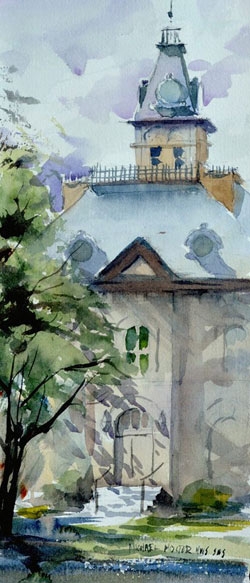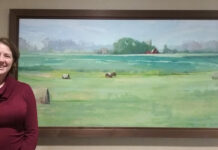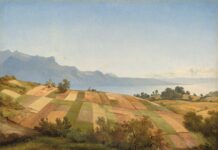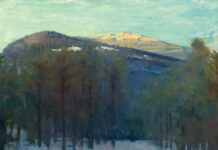
Texas has 254 counties, and in many county seats the courthouse is the most striking building in town. Michael Holter has noticed this, and he’s acting on it.

“Just Off the Square,” by Michael Holter, watercolor. Ellis County Courthouse, Waxahachie, Texas
“I have always had a love of architecture, and I thought for a while that I was going to be an architect,” says Holter. “When you travel through these towns you are struck by the courthouses. They are usually impressive structures, often situated on the town square. Sometimes they serve as the center of small communities.”

“Granbury Beacon,” by Michael Holter, watercolor. Hood County Courthouse, Granbury, Texas
Holter is starting on a project to paint all 254 courthouses. He has a ways to go—he has only depicted six so far. “Each one is a little different,” says Holter. “There are some places where the courthouse is just a flat-roofed, two-story building, but there are quite a few others that are like grand halls, with Romanesque architecture. Sometimes the town might also have church steeples or industrial structures with some height, but the courthouse is an interesting shape on the horizon as you come up on the town.”

“Llano Court,” by Michael Holter, watercolor, 5 ½ x 14 in. Llano County Courthouse, Llano, Texas
In some parts of Texas, the counties average about 900 square miles, so every 30 miles or so, a traveler can come upon another courthouse. Holter finds them interesting not just for their shape, but for what they represent. “It’s interesting that, in this land of democracy, they chose to build the centers of the government as the dominating facet of their communities. The courthouses are the tallest things in some of these towns, so it’s kind of a tribute to democracy.”

“Auction on the Courthouse Steps,” by Michael Holter, watercolor, 10 x 7 in. Ellis County Courthouse, Waxahachie, Texas. Plein air
The artist isn’t so much interested in the materials used in the construction of the pieces. This tends to vary from marble to the red or yellow stone indigenous to the area. Roofing material varies as well, with some courthouses utilizing slate and others boasting a mission look, for example. The size, design, and materials do often suggest the level of prosperity the town has enjoyed.

“The Denton Taj,” by Michael Holter, watercolor, 14 x 10 in. Denton City, Texas
Another aspect of courthouses interests Holter. “Courthouses have all this life that goes on in and around them,” he says. “Last year at the plein air event in Waxahachie I painted the Ellis County courthouse several times, and one day it was interesting—it was the first Tuesday of the month, and that means a foreclosure auction on the courthouse steps. Painting that sort of thing is fun, and you have a story to go along with the building and the painting.”

“Ft. Worth Sunday,” by Michael Holter, watercolor, 20 x 14 in. Tarant County Courthouse, Ft. Worth, Texas
Holter doesn’t have definite plans for the watercolor paintings produced by his venture, although he hopes for an exhibition. He notes that an exhaustive book on Texas’ courthouses is already published—and has served as a valuable resource for him in his project. “It would be fun to do a show,” says Holter. “I probably will start with that.”





I have had the pleasure of painting with Andy. He is simply brilliant.
Andy has a gift for a simple, inclusive teaching method. The value sketch will certainly help.
Thanks for this article on plein air watercolor. I always appreciate how artists use watercolor in the field – as that is my favorite plein air medium.
Beautiful final painting!! Just love the composition and color with big value masses.
Andy, you have captured the essence of what a watercolor
painting should be. I can see the influence Alvaro has had
on you. He is one of my favorites also.
Nice, inspiring. Bold, good strokes in the trees, and that dry brush stroke down the middle of the street shows how good and confident you are. I laughed with the pleasure of seeing that mass-tone red spot.
You’re as bold as they come, your constant practice makes the media be all that it can be. If you outline your whites in you’re drawing stage then when you wet the paper with water you can leave that area dry. I remove the white’s outline after the local color wash is dry.
Nice article. Would like to see more of this in the magazine.
Great painting ! Does anyone know if Judy Wagner, Maine ,watercolorist, is still working ?
Why do we have to go through this laborious “cryptic word” thing to submit a comment ?
Its a pain !
What top transparent colors do you like to work with?
Scott,
Here’s a bit more information about Andy’s supplies: Payne’s gray, French ultramarine blue, cobalt blue, cerulean blue, sap green, raw sienna, burnt sienna, alizarin crimson, cadmium red, new gamboge, and cadmium lemon. He paints on a 9” x 12” block of Arches watercolor paper or on quarter sheets of 300-pound cold-pressed watercolor paper, dampening the surface before he begins painting and keeping it slightly elevated so gravity will cause the fluid paint to move down without running
Love seeing watercolor used in the field and hopw to see more in upcoming articals. Andy has mastered his goal in loose plein air painting!
Judi Wagner, the watercolorist, died in Oct. 2010 of cancer. Check out her web site at http://www.Judiwagner.com.
Andy love the demo and the story from your local paper on the farm house…you know we think you are a rare talent! We look forward to hosting your workshop in December again this year… Jo
VERY SUBSTANTIAL POINTS TOLD BRIEFLY AND SIMPLY WHICH CAN BE READILY PUT TO PRACTICAL USE TO IMPROVE THE RESULT.